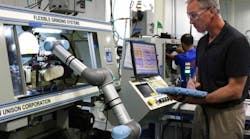In 2018, cobot production had a dramatic increase of 60% over 2017. That translates into 19,000 cobots sold for over $550 million, according to a new study from Interact Analysis.
By 2027, the prediction is that revenues for cobots will reach $5.6 billion, accounting for almost one-third of the total robotics market.
Cobots that weigh either less than 5kg and between 5-9 kg cobots are popular in small to medium-sized industrial settings and will represent the majority of sales in 2023.
Material handling, assembly and pick & place will be the three biggest applications of collaborative robots. But these functions, which accounted for 75% of cobot revenues in 2018, will drop to below 70% total revenues by 2023, as other functions for cobots are developed.
The use of cobots in non-industrial applications will play a significant role in the coming years - in sectors such as life sciences, logistics, and the hospitality sector. In part this is because they are flexible and easy to set up, making them attractive to smaller companies that may not have previously considered using robots.
Labor shortages and the drive to improve efficiency mean that China will be the fastest-growing region for cobot shipments. The demand for simple, cost-effective, entry-level robots, together with different regulations surrounding industrial equipment in China has fuelled the growth of Chinese cobot manufacturers who only supply their local market.
This has arguably distorted the market figures. Interact Analysis has responded to this by including in its report two data sets, one with and one without the impact of China. It is important to note, however, that growth outside of China is still forecast to rise at an annual growth rate of over 30% in the next 5 years.



